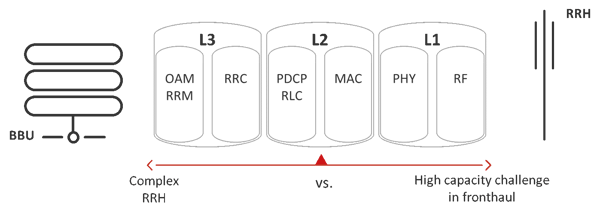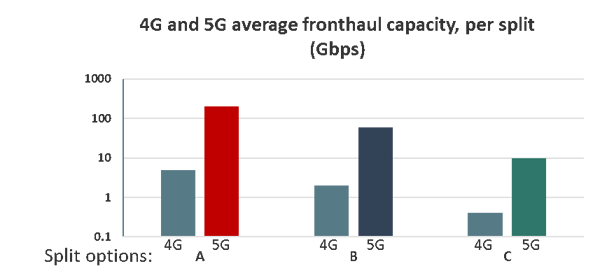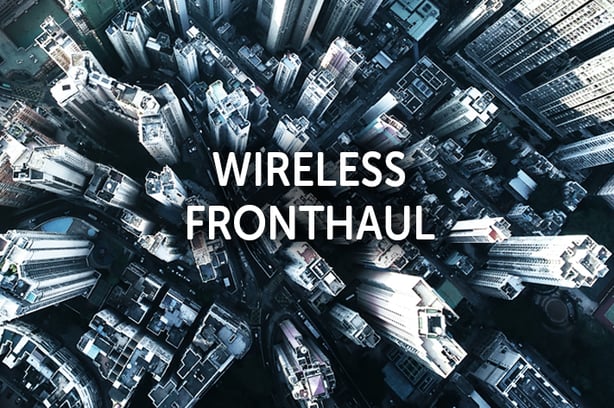The Fronthaul Perspective
Last week, we reviewed the need for capacity over 10Gbps, focusing on wireless transmission for enterprise and data-center connectivity. These are common use cases for ISPs, CLECs and MSOs, as well as for mobile operators. There is, however, a second use case that will become very significant with mass deployment of 5G cells. This use case is fronthaul.
Fronthaul – why and what?
The main drive to go fronthaul is the need for deployment of massive number of sites, typically in dense urban areas.This need is an outcome of two main trends in mobile networks: the growing demand for capacity in Gigabit LTE and 5G networks; and the use of higher frequency bands for 5G NR, which dictates a shorter distance between the cell site and the mobile device. The fact that we may need up to 5 times the number of cell sites in urban areas for 5G deployment (compared to an existing 4G/4.5G network grid) means a lot of new sites, and fast.There are two main approaches for deploying those cells, which will predominantly be located at street level. Small cells and distributed cells.While small cells are fully functional RAN elements (albeit at a lower scale), distributed cells aim to create an ecosystem in which the cell-site equipment is scaled down in terms of functionality and leverages significantly reduced CAPEX.This is done by splitting the cell site functionality into a baseband unit (BBU) and a remote radio head (RRH). The RRH, which is installed in the new cell site, handles only the RF functionality, allowing it to be simple and low cost. The rest of the cell functionality (from RRM to PHY) is done in the centralized BBU, located at the macrocell site or at a data center. This leverages economies of scale and contributes to better adjacent cell coordination and increased performance at the cell edges.
There is some trade-off, though. The scaled-down functionality of the RRH makes the traffic between it and the BBU very inefficient. For the RRH to handle only the RF functionality, the BBU needs to send it I and Q values. This inflates the traffic between the BBU and the RRH, namely fronthaul traffic.
Backhaul and fronthaul deployments

Fronthaul – how much and… how?
Fronthaul capacity is the major challenge of deploying distributed cells within the centralized or cloud RAN (C-RAN) architecture. In the 4G realm, a 10Gbps connection might be enough to support some fronthaul scenarios. But when it comes to 5G, using higher frequencies bands and dealing with much wider challenges in the RAN inflate fronthaul capacity, and challenges the current fronthaul scheme (based on protocols such as CPRI and OBSAI). With the current protocols, the fronthaul capacity per RRH, using wide channels (up to 500MHz) at the RAN, accumulates to 10s and even 100s of Gbps. This calls for ultra-high-rate interfaces in both the RRH and the BBU, as well as the introduction of DWDM technology to this part of the network. Both of which contradict the goal of making the distributed-cell architecture cost-efficient. The solution is a change in the functional split between the BBU and the RRH. The idea is to make the RRH responsible for a couple of additional functions, but, in turn, make the fronthaul interface one that carries significantly less traffic. This approach is illustrated below:
Functions split between the BBU and RRH

There are different split options discussed in the industry today, focused on the MAC and PHY layers, as shown in the following graphic:
Functional split options between the BBU and RRH

Two additional notable split points are 7.2 (FFT symbol level) – eCPRI (promoted by the O-RAN Alliance), and 2 (PDCP layer) – 3GPP F1 interface. All of which result in lower fronthaul capacity and a standard Ethernet interface, bringing fronthaul back to feasibility in 5G networks, as illustrated:

Wireless Fronthaul
This brings us back to the goal of distributed cells. In order to fully leverage their benefits in terms of cost savings and fast time to market, the new fronthaul schemes allow operators to deploy RRHs in sites where fiber is not available, using wireless fronthaul. For that, wireless point-to-point connectivity should scale to 10Gbps and above. These types of capacities call for 20Gbps wireless backhaul and fronthaul solution.
The IP-50E universal E-band radio helps you meet your capacity requirements of up to 20Gbps, simplify network deployment and installation, and reduce your spectrum costs.
What Capacity Do You Need for 5G Backhaul?


